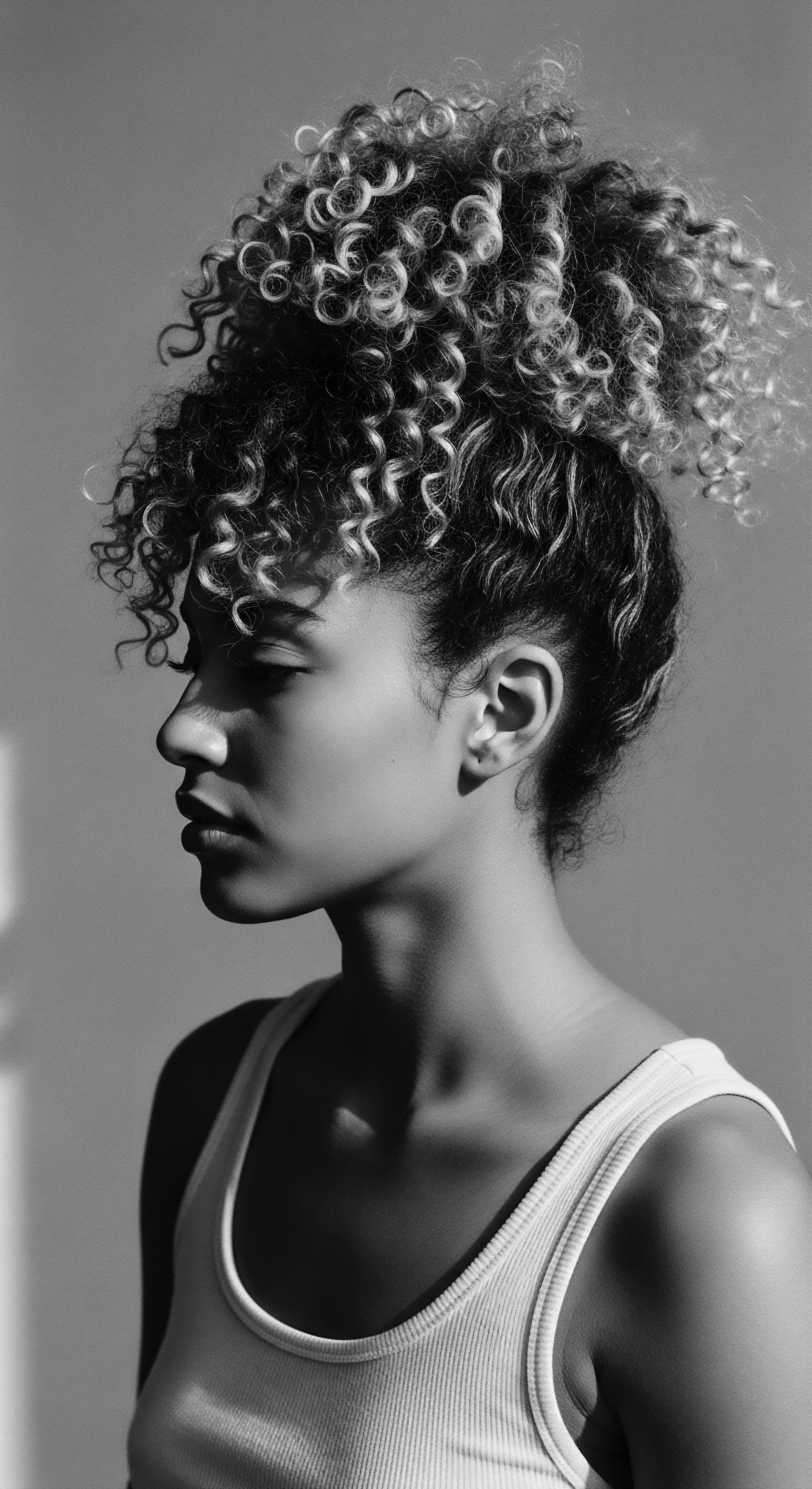
Roots
As the quiet whisper of a breeze moves through the foliage, so too does a profound current move through us, connecting generations through the very strands that crown our being. For those with textured hair, this connection is more than poetic sentiment; it lives within the very structure of each coil, each curl, a vibrant testament to a heritage that stretches back across continents and centuries. To truly appreciate the story held within a single strand, we listen to the wisdom of our forebears, those who understood the hair not as a mere adornment, but as a living archive, a repository of identity, status, and spirit.
The journey into ancestral hair practices is a journey into self, a deep inquiry into the enduring wisdom that continues to shape our routines and perceptions today. It is a dialogue between the microscopic biology of a hair fiber and the macrocosmic tapestry of human experience, a conversation held in the language of tradition and the quiet confidence of belonging. Our textured hair, with its remarkable resilience and unique character, stands as a direct, tangible link to those who came before, carrying echoes of their ingenuity, their communal spirit, and their unwavering connection to the natural world. This understanding, this deep appreciation for our hair’s lineage, unlocks a different kind of beauty, one that is rooted in ancestral memory and the profound continuity of human story.

The Anatomy of Inherited Beauty
Unpacking the physical attributes of textured hair reveals a magnificent biological design, perfectly adapted to diverse environments, reflecting the beauty of human variation. Unlike straight hair, which typically grows in a circular cross-section, textured hair often emerges from an oval or elliptical follicle, causing the strand to bend and curve as it grows. This structural characteristic gives rise to the unique patterns of curls, coils, and waves that define textured hair. The twists and turns of each strand mean more points where the cuticle, the outer layer of the hair, can lift, potentially leading to increased moisture loss and a perception of dryness.
This inherent quality, however, also provides extraordinary volume and protective capabilities. Our ancestors understood these qualities intuitively, developing practices that honored the hair’s natural architecture, working with its inclination rather than against it.
Ancestral practices reveal an intuitive understanding of textured hair’s unique biology, shaping care routines that honored its natural form.
Within the hair shaft itself, the distribution of keratin, the protein that forms hair, is not uniform in textured strands. This uneven distribution contributes to the hair’s strength in some areas and its flexibility in others, allowing for its incredible ability to coil and shrink. The density of textured hair follicles on the scalp is also often higher than other hair types, contributing to the rich fullness and volume that many textured hair wearers experience. These biological realities are the canvas upon which centuries of cultural expression have been painted, each twist and turn a testament to the hair’s inherent splendor.

A Nomenclature Rooted in Heritage
The language we use to describe textured hair today often falls short, struggling to capture the vastness of its manifestations. Historical classifications, particularly those imposed during eras of oppression, frequently used derogatory terms to denigrate hair that did not conform to Eurocentric standards. The natural hair movement, however, has championed a reappropriation of language, creating a lexicon that celebrates the diversity of textured hair.
We find ourselves in a period of reclaiming terms, of giving voice to what was silenced, and of honoring ancestral modes of description. For instance, the term ‘nappy,’ historically used as a derogatory descriptor, has been positively reappropriated by Afrodescendants, reflecting a reclamation of identity and pride in their hair (Natural Hair Movement, 2000s).
Ancestral societies, long before modern typology, possessed their own deeply descriptive ways of identifying hair types, often linked to tribal affiliation, spiritual beliefs, or social status. These terms were not about rigid categorizations but about communal identity and shared cultural understanding. For example, specific braiding patterns were identifiers, showcasing ethnic backgrounds or geographical locations among West African groups like the Wolof, Mende, or Ashanti. The visual language of hair conveyed belonging, wealth, age, and marital status, a rich tapestry of non-verbal communication that far exceeded simple aesthetic preference.
| Historical Descriptor Irun Kiko (Yoruba) |
| Ancestral Cultural Significance A thread-wrapping style, signifying femininity, marriage, or coming-of-age rites. |
| Modern Parallel or Reclamation Early form of protective styling, inspiring contemporary thread-wrapping techniques. |
| Historical Descriptor Jataa (Hindu Vedic) |
| Ancestral Cultural Significance Twisted locks worn by figures over 2,500 years ago, representing spiritual connection. |
| Modern Parallel or Reclamation Dreadlocks, a style with spiritual and identity associations across various cultures. |
| Historical Descriptor Canerows/Cornrows |
| Ancestral Cultural Significance Marked tribe, social status, age, marital status, wealth, kinship, religion, or personality. Used to hide seeds or maps during enslavement. |
| Modern Parallel or Reclamation A foundational protective style, a symbol of resilience and cultural pride. |
| Historical Descriptor Bantu Knots (Zulu) |
| Ancestral Cultural Significance Symbols of femininity and beauty; a protective style. |
| Modern Parallel or Reclamation A versatile protective style, celebrated for its definition and cultural roots. |
| Historical Descriptor Fulani Braids (Fula people) |
| Ancestral Cultural Significance Express identity, heritage, social status, often adorned with beads, cowrie shells, symbolizing beauty and wealth. |
| Modern Parallel or Reclamation A popular braiding style often incorporating traditional adornments, a statement of heritage. |
| Historical Descriptor Hair nomenclature, through history, has consistently reflected social structures and cultural values. |
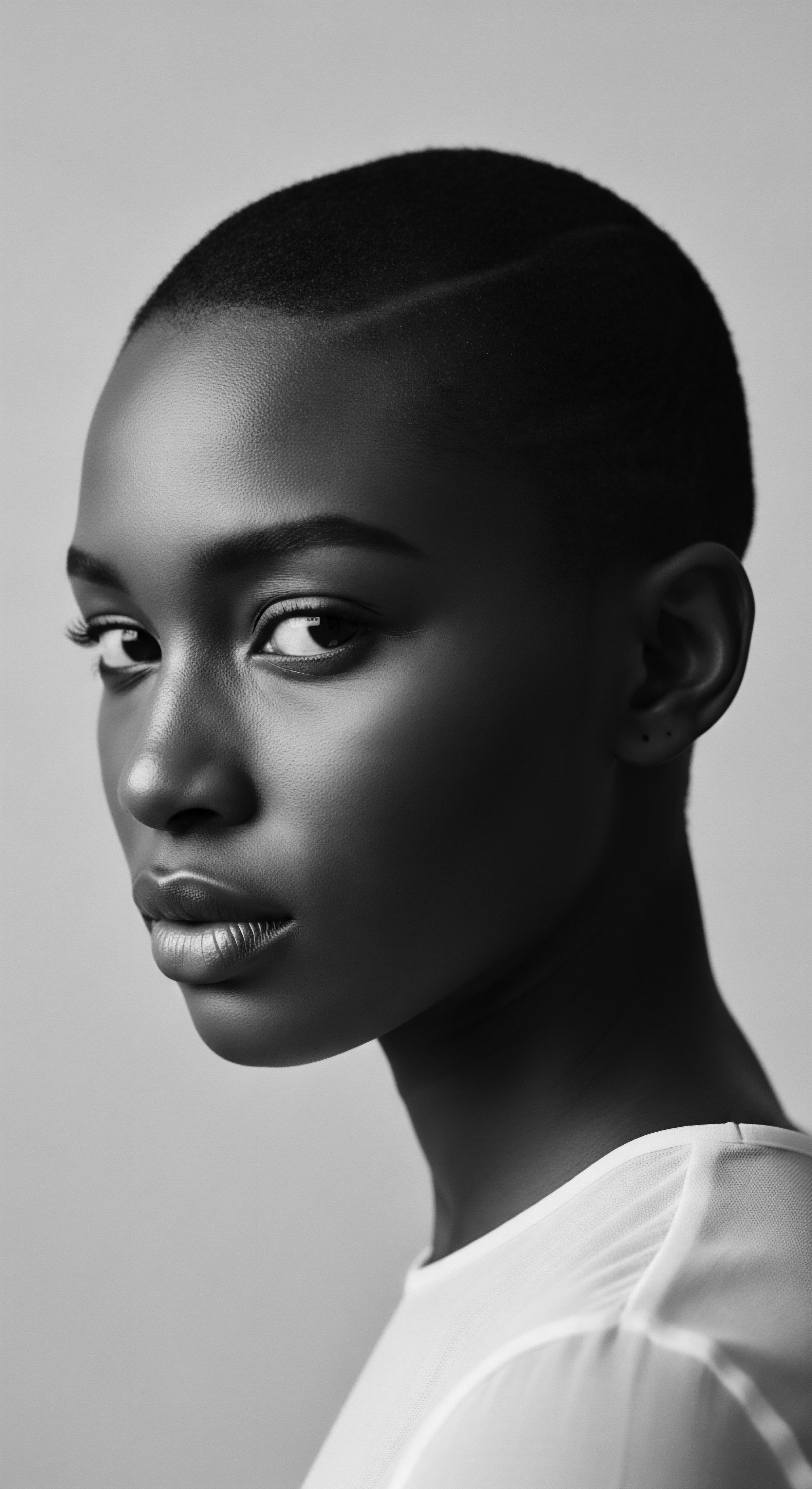
Hair Growth Cycles and Earth’s Influence
The human hair growth cycle is a fascinating biological rhythm, yet for textured hair, this cycle can experience unique challenges and opportunities influenced by ancestral environments. The coiled structure of textured hair means that natural oils produced by the scalp struggle to travel down the hair shaft, leaving the ends more prone to dryness. In ancestral landscapes, where access to specialized products was non-existent, communities relied on natural resources to provide moisture and protection.
For instance, the shea tree, native to West Africa, yielded shea butter, an ingredient used for centuries to protect skin from sun, wind, and dust, and to moisturize hair. Argan oil, extracted from the argan tree primarily in Morocco, was also used for its nutritive and cosmetic properties, with Berber women traditionally collecting undigested pits to produce this precious oil.
The climate and available flora played a significant role in shaping traditional hair care. Communities in arid regions, for example, developed practices focused on deep moisturization and protection from environmental aggressors. This historical interaction between human hair biology and the natural world allowed ancestral communities to develop sophisticated, albeit unscientific by modern metrics, care regimens that are surprisingly effective. The ancestral wisdom observed the hair’s tendency towards dryness and responded with methods to seal in moisture and protect the delicate strands, laying groundwork for today’s understanding of natural hair care.
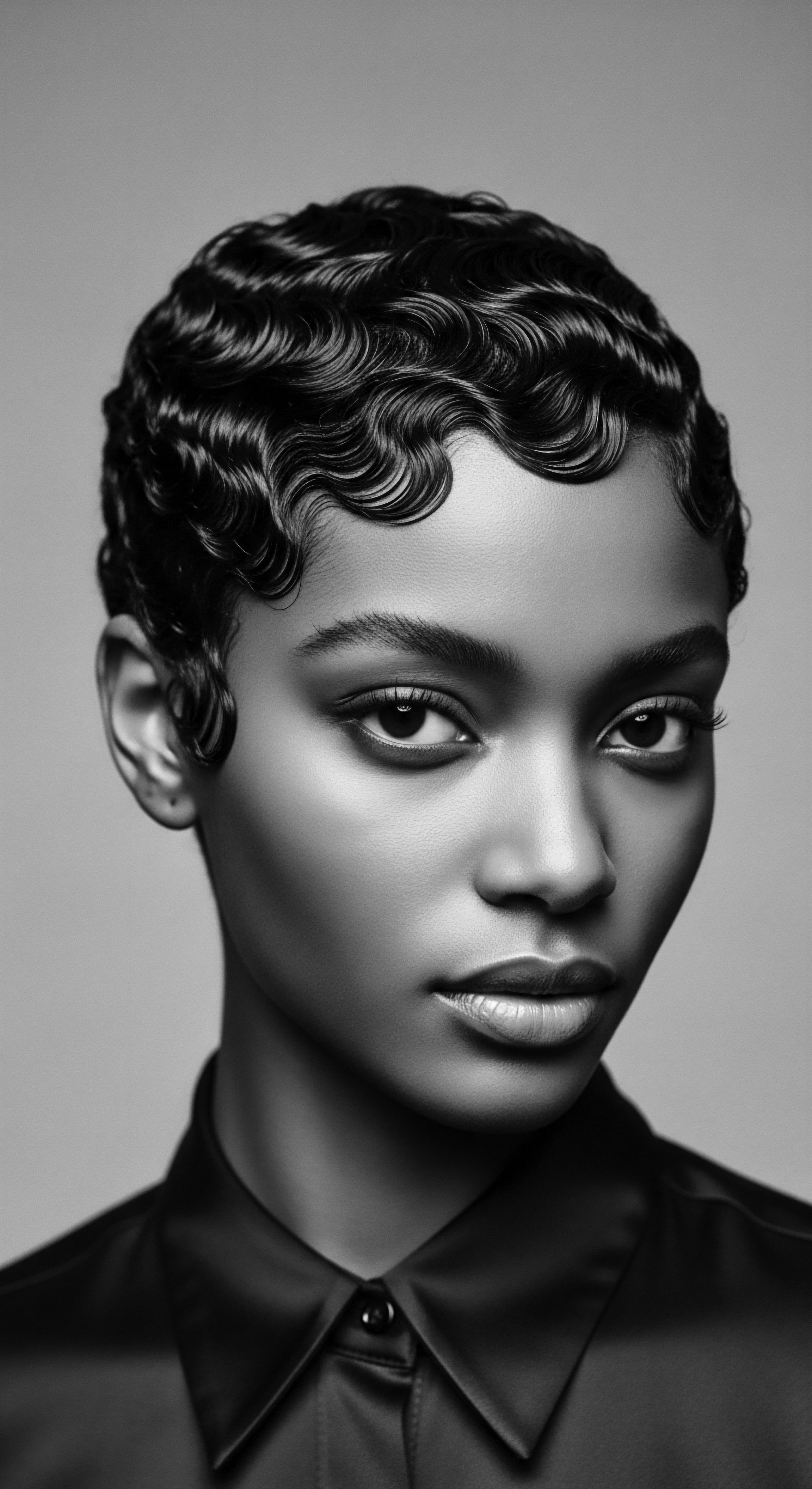
Ritual
From the foundational understanding of textured hair’s anatomy, our journey leads us to the rich tapestry of ritual, the heart of ancestral hair practices. These were not random acts of grooming. They were deliberate, often communal, expressions of identity, spirituality, and social cohesion, carrying meaning far beyond mere aesthetics. The very act of tending to hair was a sacred communion, a thread linking the individual to their family, their community, and the spiritual realm.
Hair, especially the crown of the head, was often seen as the point of entry for spiritual energy, a conduit to the divine. This profound understanding infused every gesture, every braid, every adornment with deep cultural weight.
These practices, honed over millennia, represent a living library of ingenuity and wisdom, a heritage that continues to resonate in modern textured hair traditions. The techniques, the tools, and the very spirit of care passed down through generations are echoes of a time when hair was a powerful form of communication, telling stories of lineage, status, and life’s passages. We discern the rhythmic cadence of ancient hands in the contemporary styles that define textured hair today, a continuity of artistry and purpose.

The Artistry of Ancestral Braids and Twists
The ancestral art of braiding and twisting stands as a profound legacy, a testament to intricate skill and deep cultural meaning. Styles such as cornrows, tracing their origins back to 3000 B.C. Africa, served as identifiers of tribe, social status, and even personality. The patterns themselves conveyed information, with distinct styles marking individuals from the Wolof, Mende, or Ashanti tribes.
These elaborate designs were not merely decorative; they were a visual language, a social contract worn on the head. For example, among the Fulani people of West Africa, specific braids adorned with beads and cowrie shells signify marital status and heritage.
A particularly poignant example of this coded communication emerged during the transatlantic slave trade. Enslaved Africans, stripped of their material possessions and cultural markers, found ways to preserve their heritage and resist oppression through their hair. Historians suggest that intricate cornrow patterns were used to map escape routes for enslaved people, with various directions signifying specific pathways and adornments like beads marking points along the route.
Furthermore, enslaved individuals would sometimes hide seeds or grains of rice within their cornrow braids to ensure survival during the arduous Middle Passage. This practice underscores the profound resilience and intelligence woven into these ancestral hair traditions, transforming a personal style into a clandestine tool of survival and resistance.
Hair, particularly in African cultures, has served as a powerful medium for non-verbal communication, identity assertion, and the preservation of cultural heritage.
The very process of styling was a communal affair. Hairdressing, often time-consuming and complex, was a social activity where family and friends gathered, sharing stories, gossip, and advice. This ritual strengthened communal bonds, becoming a space for cultural transmission across generations. The communal aspect of hair care persisted even through the horrific period of enslavement, allowing individuals to recreate a sense of family and cultural continuity despite forced separation.
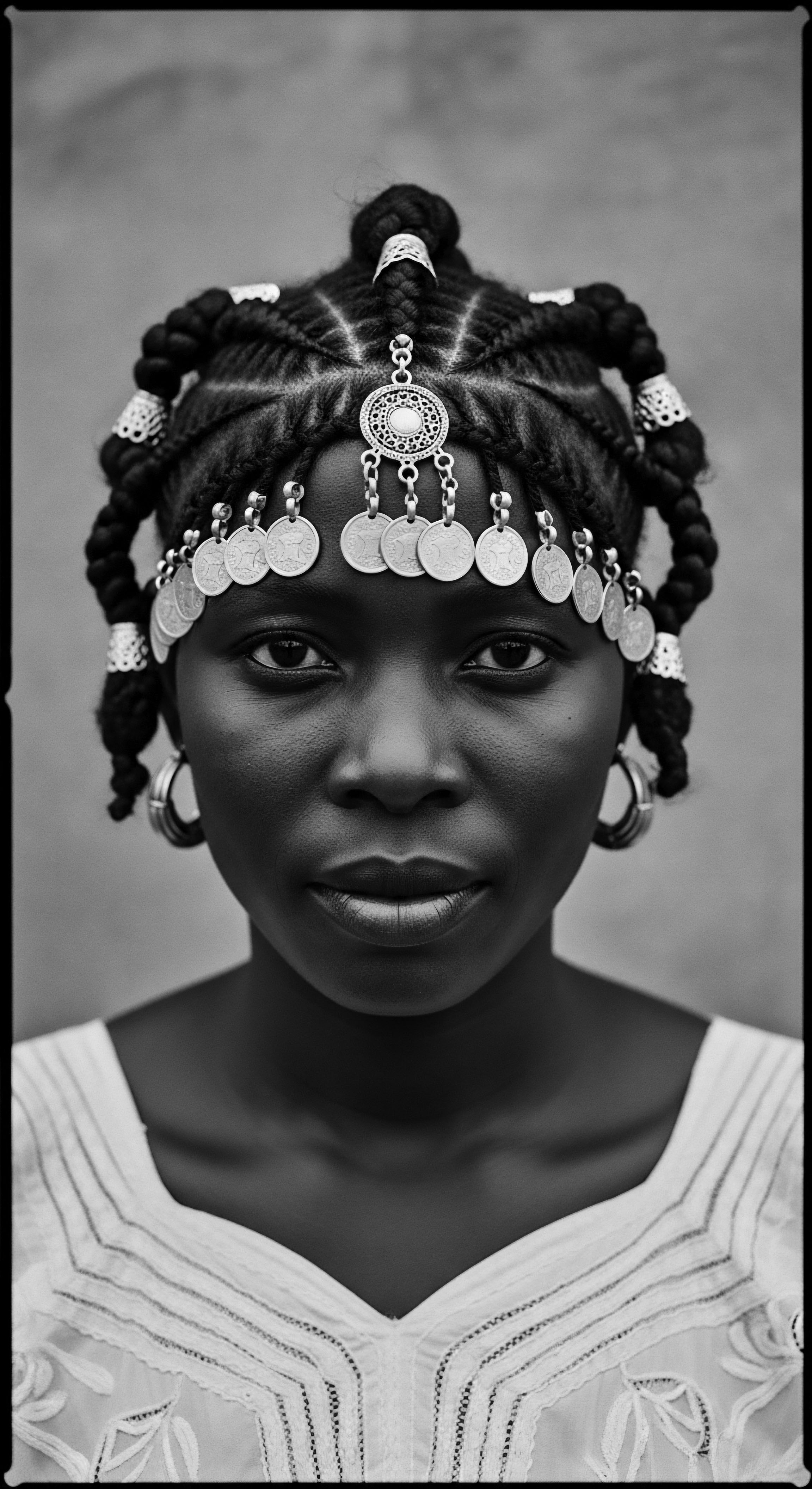
Tools and Traditional Adornments
The tools and adornments used in ancestral hair practices were deeply connected to the natural world and held significant symbolic value. Beyond their functional purpose, combs carved from wood, bone, or ivory were often intricately designed, bearing motifs that reflected social and spiritual aspirations. These were not just implements; they were extensions of a reverence for hair itself, often passed down through families.
Similarly, traditional hair ornaments were rich with meaning. Beads, cowrie shells, and precious metals were not simply decorative additions; they conveyed messages of wealth, beauty, fertility, and a connection to ancestral lineage.
Consider the Maasai people of East Africa, who traditionally used elaborate braids made from animal hair and adorned with beads to represent wealth and status. In ancient Egypt, hairstyles and wigs were often adorned with gold and other precious materials, symbolizing wealth and a direct connection to the gods. These practices highlight a holistic approach to hair, where its care and presentation were interwoven with economic, social, and spiritual dimensions of life.
- Combs ❉ Carved from materials like wood, bone, or ivory, often bearing symbolic designs, serving functional and ritualistic purposes.
- Adornments ❉ Beads, cowrie shells, and metal accents, which could signify wealth, marital status, tribal affiliation, or spiritual protection.
- Natural Fibers ❉ Plant fibers or animal hair, used to create extensions for length, volume, or specific styles.

The Nighttime Sanctuary and Protective Wisdom
The practice of protecting hair during sleep, a cornerstone of modern textured hair care, echoes ancestral wisdom. While bonnets as we know them are contemporary creations, the underlying principle of preserving styled hair and protecting it from damage through the night has deep historical roots. In many African societies, headwraps and coverings were used for various reasons ❉ ceremonial purposes, protection from the elements, or even as a symbol of dignity and resilience during periods of oppression. During enslavement, headwraps protected hair from harsh conditions and subtly defied European beauty standards, allowing individuals to maintain a cultural marker.
This protective impulse stems from an understanding of hair’s fragility and its need for careful preservation. Ancestral care systems, though not always explicitly “nighttime rituals” in the modern sense, implicitly included methods to safeguard hair during rest periods. This could involve careful braiding, twisting, or covering to prevent tangling, breakage, and moisture loss. The collective memory of these protective measures lives on, informing the widespread use of silk or satin bonnets, scarves, and pillowcases today, each serving as a tender continuation of an age-old wisdom ❉ to guard the crown that connects us to our past.

Relay
The living legacy of ancestral hair practices extends beyond historical anecdote; it actively shapes the contemporary experience of textured hair, influencing modern scientific understanding, wellness advocacy, and the ongoing quest for self-acceptance. This is the relay, the continuous passing of the torch from ancient wisdom to current practice, where the inherent qualities of textured hair meet modern scientific inquiry and cultural movements. Here, the echoes of the past are not distant whispers, but resonant frequencies, guiding our understanding of health, identity, and community in the present day.
Our textured hair carries the undeniable imprint of generations, a testament to resilience forged in adversity and creativity born from necessity. The deep knowledge systems developed by African societies, for example, continue to provide a framework for holistic hair care, recognizing that hair health is inseparable from overall well-being and cultural connection. The journey of textured hair is a powerful narrative of adaptation, reclamation, and enduring beauty.
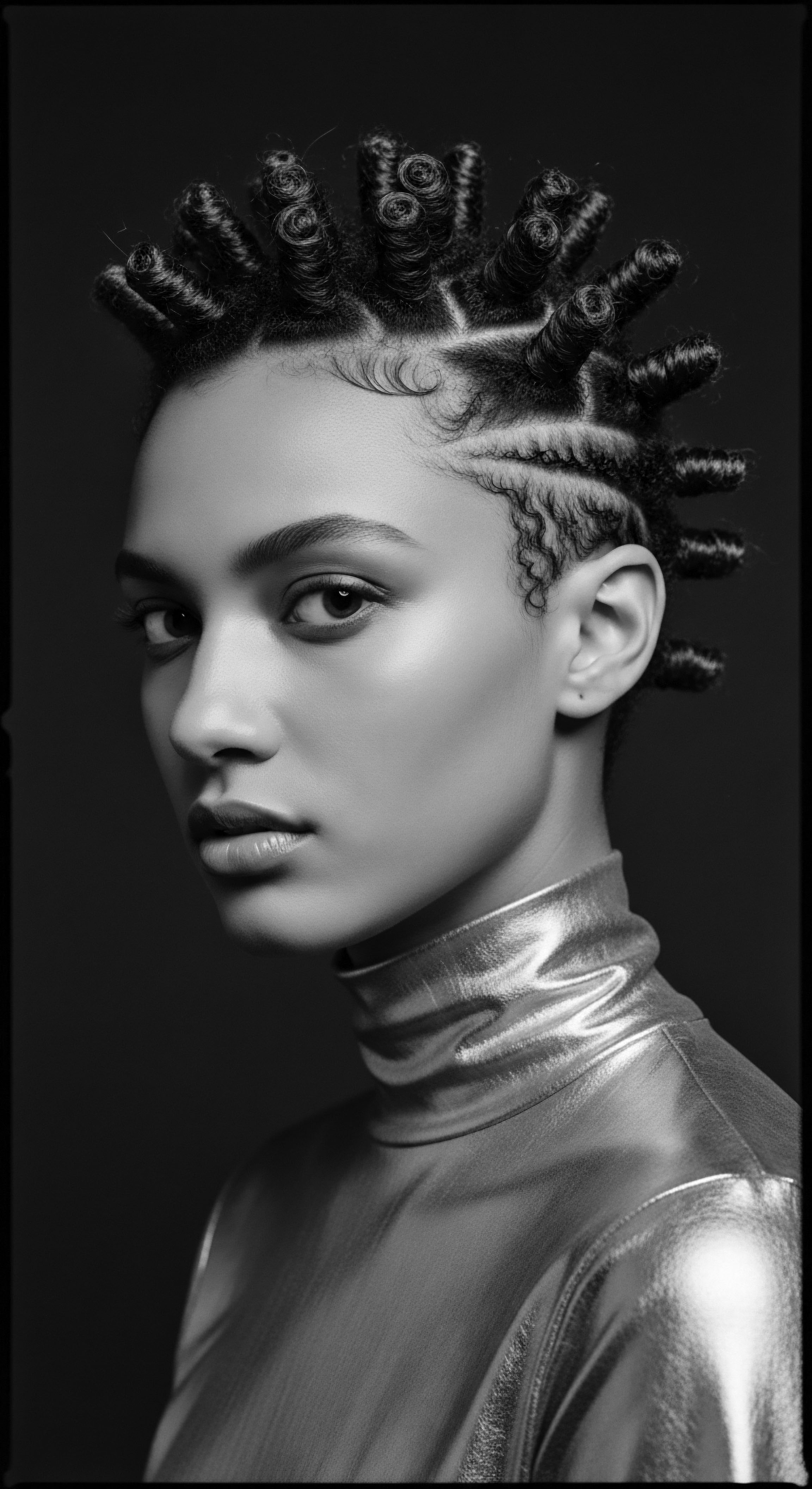
Building Regimens from Ancient Roots
The foundation of many modern textured hair regimens can be traced directly to ancestral practices that prioritized moisture, nourishment, and protective styling. Before the advent of mass-produced hair products, communities relied on plant-based ingredients indigenous to their regions. Shea butter, sourced from the shea tree in West Africa, has been used for thousands of years as a body oil and hair moisturizer, known for its ability to keep hair healthy and its anti-inflammatory properties.
Similarly, argan oil from Morocco served as a vital cosmetic and nutritive agent for hair and skin. These natural ingredients, often gathered and processed through communal efforts, formed the backbone of ancient hair care systems.
Modern hair science now validates the efficacy of these traditional components. Shea butter, for instance, is rich in vitamins A and E and essential fatty acids, making it an effective sealant for moisture retention, particularly beneficial for curly and coarse hair textures. Argan oil, with its high Vitamin E content and antioxidants, is recognized for its restorative qualities.
The continued use of these ingredients reflects a seamless continuity from ancestral wisdom to modern formulation, a recognition that the earth provides powerful solutions for hair health. The very act of oiling the scalp, a practice documented in many African hair care rituals, finds its modern validation in practices that promote scalp health as a precursor to hair growth, reflecting an age-old understanding of interconnectedness.
Natural ingredients, historically central to African hair care, possess properties that modern science now confirms are beneficial for textured hair.
The significance of these practices extends beyond mere product application; it reflects a holistic approach to well-being. Ancestral philosophies often considered hair health an extension of the body’s overall vitality, influenced by diet, spiritual state, and community support. This integrated perspective, where external care mirrors internal harmony, remains a guiding principle for many advocates of natural textured hair care today.

How Did Hair Shape Identity and Resistance in the Diaspora?
The journey of textured hair in the diaspora, particularly for Black and mixed-race individuals, is a profound narrative of identity, oppression, and unwavering resistance. During the transatlantic slave trade, enslavers systematically attempted to strip Africans of their cultural markers, including their hair practices. Shaving heads was a common tactic, aiming to sever the spiritual and cultural connection enslaved people had to their homelands and traditions.
Despite these brutal efforts, the resilience of ancestral hair practices persisted. The act of braiding, twisting, and communal grooming became a quiet but powerful act of defiance and a means to preserve cultural continuity.
This enduring connection to hair as an identity marker continued through centuries of forced assimilation. In the United States, laws were enacted in the 1800s to prohibit Black women from wearing tightly coiled natural hair in public, forcing many to conform to Eurocentric beauty standards through straightening methods like hot combs or chemical relaxers. Yet, the natural hair movement of the 1960s and 70s, coinciding with the Civil Rights Movement, saw the Afro emerge as a potent symbol of Black pride and resistance against these imposed norms.
Icons like Angela Davis wore their natural hair as a political statement, reclaiming cultural roots and challenging societal perceptions of beauty. This era represented a crucial turning point, a collective decision to embrace and celebrate ancestral hair textures as a form of self-definition and empowerment.
A statistical observation of this shift is quite telling. While historical trends saw widespread use of chemical straighteners, a report indicates that between 30% and 70% of all Black women in the United States wear natural hair today, with a striking 79% of millennial Black women under 30 years choosing natural styles (Badenhorst, 2025). This demographic change underscores a powerful reclamation of ancestral aesthetics and a collective rejection of Eurocentric beauty mandates, showcasing a conscious connection to heritage that transcends mere trends. This resurgence of natural styles such as braids, locs, and twists, styles with direct ancestral connections, serves as a continuous testament to resilience and cultural pride.

The Enduring Role of Hair in Community and Well-Being
The ancestral tradition of communal hair care, where grooming sessions were opportunities for bonding, storytelling, and the transmission of wisdom, continues to resonate in modern textured hair communities. Hair salons and barbershops, particularly in Black communities, have long served as vital cultural centers, second only to the church as spaces for cultural exchange and the sharing of knowledge (Hunter, 2017). These spaces continue the legacy of intimacy and trust, where stylists become confidantes and informal therapists, fostering deep personal connections through the shared ritual of hair care.
The holistic influences on hair health, deeply embedded in ancestral wellness philosophies, also persist. For many cultures, hair was viewed as connected to spiritual energy, with the top of the head considered the point of entry for divine communication. This spiritual significance meant that hair styling was often assigned to close relatives, reinforcing familial bonds and protecting against malevolent forces. Today, while perhaps not always overtly spiritual, the act of self-care for textured hair often becomes a meditative, affirming practice.
It is a daily ritual that honors the body, connects one to a historical lineage of care, and supports mental well-being alongside physical health. This mindful approach to hair care, informed by ancestral reverence, transforms a routine into a deeply personal act of self-love and cultural affirmation.
| Ancestral Practice Scalp Oiling |
| Traditional Purpose or Context Nourishment, spiritual connection, facilitating growth. |
| Modern Application or Validation Stimulates circulation, moisturizes scalp, supports healthy growth. |
| Ancestral Practice Protective Styling |
| Traditional Purpose or Context Social status, cultural identity, practical during labor/travel, survival. |
| Modern Application or Validation Minimizes breakage, retains length, reduces manipulation, aesthetic versatility. |
| Ancestral Practice Communal Grooming |
| Traditional Purpose or Context Social bonding, cultural transmission, storytelling, community building. |
| Modern Application or Validation Salon culture, online communities, shared knowledge, fostering sisterhood. |
| Ancestral Practice Use of Natural Butters/Oils |
| Traditional Purpose or Context Moisture retention, protection from elements, healing properties. |
| Modern Application or Validation Deep conditioning, sealing moisture, addressing specific hair concerns. |
| Ancestral Practice The continuity of these practices highlights the enduring wisdom passed through generations. |

Reflection
The vibrant world of textured hair traditions, with its intricate styles and deliberate care, stands as a profound testament to an enduring heritage. Each coil, each curl, holds within it the whispers of generations, a story of resilience, ingenuity, and unbroken cultural ties. Our hair, far from being a mere aesthetic feature, truly serves as a living, breathing archive of ancestral wisdom, a continuous thread connecting us to the past, affirming our presence in the present, and shaping the future.
It is a crown that speaks volumes, reflecting the strength and artistry of those who came before us, and whose practices continue to guide our hands and hearts. The ‘Soul of a Strand’ ethos finds its deepest resonance in this journey, acknowledging that the path to true hair wellness is one walked with reverence for its deep and powerful lineage.

References
- Badenhorst, L. (2025). Historical Perspectives on Hair Care and Common Styling Practices in Black Women.
- Byrd, A. D. & Tharps, L. D. (2001). Hair Story ❉ Untangling the Roots of Black Hair in America. St. Martin’s Press.
- Byrd, A. D. & Tharps, L. D. (2002). Hair Story ❉ Untangling the Roots of Black Hair in America. St. Martin’s Press.
- Hunter, L. (2017). Gender, Race, and Class in Hair Styling Spaces ❉ Constructing Individual and Group Identities. Mehandi.com.
- Mbodi, M. (2020). The Significance of Hair in African Culture. Okan Africa Blog.
- Mbodi, M. (2022). The Spiritual Significance of African Hair this International Women’s Day and Beyond. Umthi Beauty.
- Rowe, K. (2021). The Evolution Of The Natural Hair Movement. Refinery29.
- Synnott, A. (1987). Shame and Glory ❉ A Sociology of Hair. British Journal of Sociology, 38(3), 381-404.
